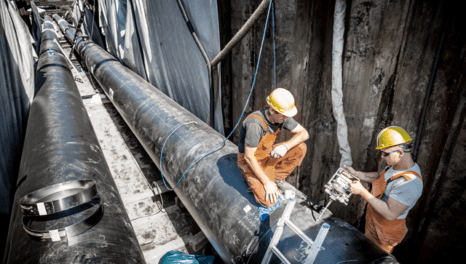Join the dots: a talk with the NIC’s Philip Graham
Jane Gray speaks with National Infrastructure Commission chief executive Philip Graham about his plan for electricity system transformation and its links to national infrastructure needs.
29th April 2016 by Networks

When chancellor George Osborne launched the National Infrastructure Commission in the autumn of last year, it had been a long time coming.
The creation of a politically neutral body capable of carrying out long-term thinking about mammoth, capital-intensive civil and industrial engineering projects is something that businesses leaders across sectors have wanted for decades. Over the years, many of them have been left bruised and disheartened by the effects of political whim (or expediency) on their ability to attract investment and deliver projects.
Policy wonks finally woke up to the seriousness of this need for long-term thinking in 2013 when Labour leader Ed Miliband commissioned Sir John Armitt to scope out what a National Infrastructure Commission might look like. The idea crossed party lines following Labour’s defeat in the 2015 general election and the Conservatives named Labour peer Lord Adonis chair of its commission in early October.
With such a back catalogue of frustrated expectations, the National Infrastructure Commission (NIC) has a lot to live up to and the pressure is on to prove it can make a tangible impact on the efficiency and coordination with which the UK approaches its increasingly complex infrastructure needs.
The National Infrastructure Commission’s Smart Power report made a clear set of recommendations to government, Ofgem and industry about the infrastructure revolution needed in the UK electricity system if it is to deliver what the wider economy and society needs by 2030 and beyond. Successfully implementing these recommendations could save consumers £8 billion.
Radical progress in three areas was identified as being particularly important to realising this saving and creating a more flexible electricity system, capable of smoothing out peaky demand and accommodating decentralised, intermittent renewable generation. These were:
Interconnection: The NIC sees increased interconnection as essential to the UK’s future energy security, and its ability to manage signifi cant difference between winter and summer demand, without having to build huge redundancy into the electricity generation. Furthermore, analysis conducted by National Grid and referenced in the Smart Power report identifi ed that the expected net benefi ts of 8-9GW of interconnection to be equivalent to nearly £3 million every day through reduced wholesale electricity prices.
Energy Storage: Essential to supporting demand-side solutions and converting intermittent renewables into something more akin to steady baseload, the NIC is optimistic about prospects for increased deployment of energy storage. Costs for storage technologies are falling across the board with the most common – lithium ion – reducing from around $3,000/kWh in 1990 to less than $200/kWh today. If costs continue to fall on this trajectory, the NIC says up to 15,000MW could be economically deployed by 2030.
Demand fl exibility: According to the NIC if 5% of current peak demand was met by demandside solutions, the energy system would be £200 million a year cheaper to run and consumers would benefi t by £790 million. Today, although some businesses engage in the demandside market, the NIC says it is underutilised. It also anticipates that the roll out of smart meters will quickly lead to entrepreneurs establishing services that bring domestic consumers into play in demand-side markets.
Philip Graham, who was named chief executive of the NIC in December, is keenly aware of this expectation and also of the need to prove to many interested parties that it is not “a transport commission in disguise” – a preconception which it would be easy to perpetuate given his own background in the rail industry, coupled with Adonis’s past as transport secretary. It was partly with these considerations in mind that the NIC made sure smart power was among the first and most meaty of the topics addressed in its research agenda.
“The report needed to make an impact,” Graham says by way of opening as he meets with Network in a nondescript, windowless office in the Treasury where the NIC has its temporary HQ. “There was a risk that the NIC was going to be seen as about ‘building stuff’. That will be part of it, but as we come to terms with that fact that we’ve squeezed as much as we can out of existing infrastructure – at the same time as facing a capacity crunch and acknowledging a finite budget for building – we must look at options alongside that for getting greater efficiency, for managing demand, for pricing things correctly. To my mind, that is where a National Infrastructure Commission can really add value, by bringing that holistic look at all of those things rather than being about just project delivery.”
Published in March, the NIC’s Smart Power report is the result of a “streamlined” but intense research process into the future of the UK’s power system and its requirements for greater flexibility. The report was warmly received by government and industry and made a number of pivotal recommendations for reform of market and regulatory structures. It said these were needed to facilitate energy system transformation and create a national energy infrastructure that was fit for purpose in a future defined by a low carbon, high productivity society with increasingly decentralised generation (see left for a summary of Smart Power findings and recommendations).
Smart power and energy storage The report pulled no punches in addressing potentially controversial elements of this transformation agenda, including the potential for an independent system operator. It also pushed out a challenging figure for the potential consumer savings to be had from the realisation of greater system flexibility: £8 billion by 2030. Explaining where that figure came from, Graham acknowledges the input of experts at Imperial College London.
Read on to discover how the NIC came up with it’s £8bn figure for potential consumer savings…
The calculation is based on projections of what it would cost to deliver the generating capacity needed to meet current peak power demands if the electricity system were to continue to be operated as it is today out to 2030, he says. “We began to think: OK, that’s what it’s going to cost to deal with continuation of this very peaky system. What about if I introduce some greater flexibility by having greater demand-side flexibility that starts to shave off some of those peaks? How much does it reduce the generating requirement? If you can shave that peak further through storage measures, how does that start to bring the cost down? If you can deal with intermittency through storage, how does that bring the cost down?”
Add in the costs of building storage, establishing demand-side technologies and – the third prong in the NIC’s roadmap to system transformation – constructing an array of electricity interconnectors, and still the consumer bill “pales into insignificance compared with the cost of providing generating capacity for the current demand profile”, says Graham.
Of course, there are reasons why these elements in an electricity system revolution are not flying ahead already, and overwhelmingly these relate to market and regulatory obstacles which stop potential market participants being able to stack up sufficiently attractive business cases – particularly in the case of energy storage deployment.
Graham is clearly an energy storage enthusiast, relaxing and brightening up as he talks about the time the NIC team spent exploring an array of different storage technologies, from compressed air and liquid air storage to flow batteries, flywheels and super-capacitors.
Apart from indulging a fascination with this “exciting and interesting” technology arena, the endgame of this exploration was not to “pick winners” Graham emphasises. It was to understand the landscape of players that regulation might need to accommodate, and to set a realistic timescale for Ofgem and Decc to identify the modifications they will need to make in order to brighten storage prospects.
The timescale that Smart Power recommends is uncomfortably tight by the standards of government departments, but should lead to an agreed agenda of reform being announced in the spring of 2017 following a consultation with industry (now ongoing).
Among the changes which the storage industry has called for most vocally to date is to overturn the current licence conditions for storage that see it classified as both an end user and a generator of electricity and hit twice, therefore, by system charges.
“The objective here is not to have commercial distribution network operators. The objective is to have effective management of those networks.”
It’s a commonly talked about barrier to storage deployment which Smart Power too highlighted, yet recent statements made by Ofgem in front of the Energy and Climate Change Committee (ECCC) make it clear that those hoping the regulator’s raft of reforms will include a new licence condition for storage are likely to be disappointed. Andy Burgess, Ofgem’s associate partner, energy systems, told the ECCC that this was “not the immediate solution”. Furthermore, Burgess flatly turned down the idea that the effective application of storage technologies – and the realisation of system flexibility – could be rapidly scaled up by allowing distribution network operators (DNOs) to own and operate the technology – something they are currently barred from doing.
What are Graham’s thoughts on these developments? Despite the fact that they seem at odds with Smart Power’s inclinations, he is unfazed and neutral.
“Whether when it comes to the crunch the right answer… is a change to the way storage is classified or whether there are other ways you can achieve the same end goal – we are not in a position to say,” he says, diplomatically. “What is clear is any single regulatory change on its own will not solve the problem.”
And what about the ability of DNOs to engage and become more commercially driven – again something the NIC seemed to advocate? Here Graham is more assertive: “We came up with a pretty strong recommendation that moving distribution networks into a position where they are more actively operated is absolutely crucial as you move to a more distributed generating system, as you move to smarter uses of power.” The changes and complications inherent in that transition “might well lead to DNOs thinking more commercially and operating some of the kinds of markets that the transmission operator does at the moment”, he says.
Read on for Graham’s views on DNO ownership of storage and the commercial future of energy networks…
Pushed on just how much commercial opportunity regulated utilities should be given in order to allow and incentivise investment in transformative technologies, Graham pauses for thought, and concludes – again diplomatically – that it is an area with potential. He apologises for not being more decisive (or controversial), but expands, “the objective here is not to have commercial distribution network operators. The objective is to have effective management of those networks, and you’d have to look at the advantages that came from introducing those commercial incentives and opportunities, balanced against the other impacts it might have on that objective”.
System Operator
Recent months have seen escalating debate in the energy industry about whether or not rising complexity in system balancing and energy markets, along with the potential for conflicts of interest within National Grid, justify the creation of an independent system operator.
Weighing into this debate, the National Infrastructure commission said in its Smart Power report: “On balance, there appears to be merit in increasing the independence of the system operator to guard against the risks of conflicts of interest and to help it to address the challenges the electricity system will face.
“However, it is not clear whether an entirely independent system operator is the right model to adopt to solve these issues. While a truly independent system operator, particularly if set up as a not-for-profit organisation, would not face actual or perceived conflicts of interest, there are trade-offs, including the increased difficulty in setting its incentives.”
Third parties and innovation
A step on from the potential of DNO commercialisation takes us to Smart Power’s thoughts on networks’ relationship with third parties. Network engagement with external partners is a topic that has enjoyed growing interest in recent months, especially in relation to innovation schemes.
The NIC’s perspective on this is that establishing new and improved ways for networks to share risk with third parties might facilitate the realisation of decentralised and diverse energy systems – the planning requirements for which are uncertain and infinitely more complex than the relatively formulaic transmission and distribution system of today.
Networks try to install the minimum level of capacity needed in any particular area, with the guarantee of a resilient supply, at the least cost to customers. But this is near impossible when they do not have a complete and finalised picture of the area’s plans for transport, housing, energy generation and storage – for instance.
“It’s not [networks’] job in the long run to be planning and working out and making decisions about where developments ought to be located or what scale they should be at,” states Graham. “The system doesn’t really allow for it at the moment, but if the infrastructure owner could work with the developer or the local authority responsible for the special plan that the infrastructure is designed to support, then between them there ought to be better information to manage risks and to understand what a viable but not unnecessarily expensive long-term plan is – and to deliver that.”
This fairer division of risks sounds like a positive step, but is it enough? Despite the flurry of activity driven by innovation funding in recent years, networks are still generally considered slow-moving and risk averse. When it comes down to it, does Graham think networks are innovative enough to realise the transition the energy system needs?
Read on for Graham’s views on network innovation…
It’s clearly not the first time he’s been asked such a question. “My impression is that they are very interested in this. They like talking about it and they are very keen on being involved in it. And certainly the larger players – National Grid – are taking it forward. “I think the difficulty is – and this comes back to why getting the market structure and the regulatory system right is so important – that they are really good at it and really interested and keen to talk about it – on a pilot basis. Or on a small-scale basis where a bunch of grants have been given out for them to try new things. “For the most part they still haven’t got the structures in place to take the results of those pilots and roll them out on a large scale.”
In short, despite their willingness, networks have not been able to hit the point where they can look at an innovation project finding and decide: “OK, that worked there. Now how can we roll it out, significantly more widely.”
Demand response and next steps for the commission
With the NIC looking for radical change in the energy system by 2030, the current situation must be frustrating. Is there a segment of the NIC’s vision for the future which Graham thinks will be quicker or easier to achieve than the rest? Going back to the three key elements of the Smart Power report – interconnection, energy storage, and demand response – he considers each in turn after stating the obligatory caveat that they mostly all move forwards together.
“Demand side gets talked about least, but I think it will make a huge difference to how we operate our homes and live our lives.”
“Interconnection is happening,” he says. “There are a whole set of projects in the pipeline, a number of which have regulatory approval including the first ‘long’ interconnector out to Norway. “But inevitably those are big multi- million or billion pound projects, so their delivery is going to take time.” And while that time plays out, Graham says he is confident that the barriers to storage playing its part in smoothing peaky demand and renewables intermittency are lined up in such a way that “will make progress happen very quickly”. Which leads him to the last element – demand-side solutions.
This is an area that “gets talked about least, but I think it will make a huge difference to how we operate our homes and live our lives – as well as to businesses that are already using it”. Smart Power identified that £200 million a year could be shaved off the operating costs of the grid in the UK if 5% of demand could be met using demand-side solutions. The report cited international leaders like Australia and the US as demonstrating how more mature markets are already using demand-side response effectively. Optimistically, Graham predicts that “by the 2020s we will think it is very odd to just run your dishwasher at the point at which you’ve filled it up. It will become second nature to be taking decisions on how you use electricity depending on how it is priced”. This could be directly or via an automated service based on clever algorithms.
What this will mean for networks is, of course, closely tied up with developments in the retail market. But it will also hinge on parallel revolutions in community energy, changes in the way consumers and businesses heat their properties (a major use of energy), the potential electrification of transport and, last but not least, the creation of new housing stock built with smart power in mind.
All of these different elements, spanning multiple sectors and government departments, fall within the scope of the NIC’s long-term remit to produce a National Infrastructure Assessment over the course of this parliament which will specify a structured way of thinking about “multi-modal” infrastructure needs. It’s hoped this assessment will not only help prioritise investment in a timely and co-ordinated way, but also address the fact that UK infrastructure project costs are often seen to far outstrip international comparators.
If this Holy Grail of infrastructure planning seems tantalisingly far off though, Graham has news of a nearer term project that should achieve a similar level of insight, if at a smaller scale. Over the next six months the NIC will work on a multi-modal study of the infrastructure needs of the Oxford-Cambridge corridor, running through Milton Keynes and Bedford.
“It’s an area that links some of the most productive, highly skilled economies in the country and as a result it is seeing increasing pressures in terms of housing stock,” says Graham, setting out the logic for the study. “Yet in pockets either side of it you see areas of significant deprivation where economies are depressed and jobs are hard to come by.” The NIC’s report, therefore, will look both at servicing the needs of existing and growing productivity, and at how to link that affluence to areas of deprivation in order to raise them up.
Taking in housing, transport, energy and water planning and more, the NIC hopes the report will give infrastructure owners a rare, sharply defined view of the kinds of investment and technology choices they will need to make, alongside others, in the next five to ten years.
Comments
Login on register to comment
Related content

Heat
Electric storage heating – a Cinderella solution
Why has electric storage heating been overlooked as we seek to tackle decarbonising domestic heat?

Heat
Prospects bright for landmark East London Heat Network
New Vattenfall-Cory partnership marks step towards record-breaking heat network capable of serving over 10,000 homes

Heat
New construction director at Switch2 Energy
Appointee brings experience from Vattenfall and Eon
Related supplier content
![‘Learning by doing’ on the road to net zero [test product]](https://networksonline.s3.amazonaws.com/products/images/3.jpg)
People & Skills
‘Learning by doing’ on the road to net zero [test product]
DSO director Andrew Roper discusses 'Learning by doing'

Power
Load patterns and lockdown: how Covid-19 is impacting electricity networks
Insights into dynamics on the low voltage network as the outbreak unfolds

Heat
How E.ON. is helping the City of London become a zero emissions city
Discover Citigen. Deep in the heart of our bustling capital